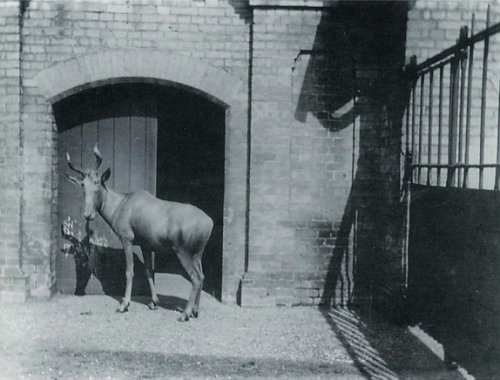Alcelaphus buselaphus buselaphus Pallas, 1766:7
Bubal hartebeest, Northern hartebeest, Bubal antelope, Bubal
Taxonomy & Nomenclature
Synonym/s: Bubalis buselaphus Pallas, 1766:7
Conservation Status
Extinct
Last record (captive animal): 9 November 1923
Last record (wild animal): 1925 (Loggers et al., 1992; Gippoliti et al., 2017); 1945 (doubtful record) (see Loggers et al., 1992)
IUCN RedList status: Extinct
Distribution
Northern Africa (Algeria, Egypt, Libya, Morocco and Tunisia)
Biology & Ecology
Hypodigm
Media
There appears to only be a single photo of a living Bubal hartebeest, taken in 1895 by Lewis Medland of an animal that lived at London Zoo from 4 October 1883 until 27 April 1897.

References
Original scientific description:
Pallas, Peter Simon. (1766). Miscellanea zoologica quibus novae imprimis atque obscurae animalium species describuntur et observationibus iconibusque illustrantur. The Hague, Netherlands: Petrum van Cleef. ixii + 1-224 pp., pls. 1-14.
Other references:
Aulagnier, S. and Thévenot, M. (1986). Catalogue des mammifères sauvages du Maroc. Trav. Inst. sci., Sèr. zool., 41.
Bédé, P. (1926). Notes sur l'ornithologie du Maroc. Mém. Soc. Sci. nat. Maroc 16: 25-31.
Cabrera, A. (1932). Los mammiferos de Marruecos. Trab. Mus. nav. Cienc. nat., Madrid, Ser. zool. 57: 1-361.
Day, David. (1981). The Doomsday Book of Animals: A Natural History of Vanished Species. New York, N.Y.: The Viking Press.
Dollmann, J. Guy. (1937). Mammals which have recently become extinct and those on the verge of extinction. J. Soc. Preserv. Fauna Empire n. s. 30: 67-74.
Edwards, John. (1996). London Zoo from Old Photographs: 1852-1914. London: John Edwards. 240 pp.
Flagstad O, Syversten PO, Stenseth NC & Jakobsen KS (2001): Environmental change and rates of evolution: the phylogeographic pattern within the hartebeest complex as related to climatic variation. Proceedings of the Royal Society of London. B, 268: 667-677.
Fuller, Errol. (2013). Lost Animals: Extinction and the Photographic Record. London: Bloomsbury Publishing.
Gippoliti, Spartaco, Cotterill, Fenton P. D., Zinner, Dietmar and Groves, Colin P. (2017). Impacts of taxonomic inertia for the conservation of African ungulate diversity:an overview. Biological Reviews. doi: 10.1111/brv.12335
Goodwin, Harry A. and Goodwin, J. M. (1973). List of mammals which have become extinct or are possibly extinct since 1600. Int. Union Conserv. Nat. Occas. Pap. 8: 1-20.
Gosling, L.M. and Capellini, I. 2013. Alcelaphus buselaphus Hartebeest. In: J. S. Kingdon and M. Hoffmann (eds), The Mammals of Africa, pp. 511-526. Bloomsbury Publishing, London, UK.
Gruvel, M. A. (1937). North Africa—two vanishing species. J. Soc. pres. fauna Emp. 30: 62-64.
Haltenorth, T. and Diller, H. (1980). A Field Guide to the Mammals of Africa, including Madagascar. London: Collins.
Heim de Balsac, H. (1928). Notes sur la présence et la réparition de quelques grands mammifères dans le sud-oranais et le Maroc oriental. Revue fr. Mammal., Ser., 1: 83-92.
Hudon, Daniel. (2014). Eulogies for Lost Species. Clarion 17: 59-63.
IUCN SSC Antelope Specialist Group. (2008). Alcelaphus buselaphus ssp. buselaphus. In: IUCN 2011. IUCN Red List of Threatened Species. Version 2011.1. (http://www.iucnredlist.org). Downloaded on 26 June 2011.
IUCN SSC Antelope Specialist Group. 2017. Alcelaphus buselaphus ssp. buselaphus. The IUCN Red List of Threatened Species 2017: e.T813A50181474. https://dx.doi.org/10.2305/IUCN.UK.2017-2.RLTS.T813A50181474.en. Accessed on 04 July 2022.
Lavauden, L. (1926a). Les Vertébrés du Sahara. Guénard, Tunis.
Lavauden, L. (1926b). Les gazelles du Sahara central. Bulletin de la Société de l'Histoire naturelle de l'Afrique du Nord 17: 11-27.
Lemoine, Rhys Taylor, Buitenwerf, Robert, Faurby, Sören and Svenning, Jens-Christian. (2025). Phylogenetic Evidence Supports the Effect of Traits on Late-Quaternary Megafauna Extinction in the Context of Human Activity. Global Ecology and Biogeography 34(7): e70078. https://doi.org/10.1111/geb.70078 [Supporting Information: Data S1]
Loggers, Chris O., Thévenot, Michel and Aulagnier, Stéphane. (1992). Status and distribution of Moroccan wild ungulates. Biological Conservation 59: 9-18.
Lydekker, Richard and Blaine, G. (1914). Catalogue of the ungulate mammals in the British Museum (Natural History). Trustees of the British Museum, London, volume 2.
Meakin, B. (1901). The Land of the Moors: a Comprehensive Description: London: Swan Sonnenschein.
Panouse, J. B. (1957). Les mammifères de Maroc. Trav. Inst. scient. chérif., Sér. Zool. 5.
Powell-Cotton, P. H. G. (1937). The northern hartebeest. J. Soc. Pres. Fauna Emp, 30: 65-66.
Raethel, H. S. (1986). Zur Biologie, Ausrottung und künstlerischen Darstellung der Nördlichen Kuhantilope (Alcelaphus buselaphus buselaphus Pallas, 1766). Zool. Garten., 56: 91-105.
Ruxton, A. E. and Schwarz, E. (1929). On hybrid hartebeests and on the distribution of the Alcelaphus buselaphus group. Proceedings of the Zoological Society of London 1929: 567-583.
Seurat, L. G. (1943). Faune du Maroc méridional et du Sud Oranais. Bull. Soc. Sci. nat Maroc 23: 151-158.
De Smet, K. 1989. The distribution and habitat choice of larger mammals in Algeria, with special reference to nature protection. Ph.D. Thesis, University of Ghent.
Thouless C (1996): Aerial Survey for Wildlife in Omo Valley, Chew Bahir and Borana Areas of Southern Ethiopia. Gnusletter, 1: 20-25.
Wilson, D. E. and Reeder, D. M. (2005). Mammal species of the world: a taxonomic and geographic reference. Third edition. Baltimore, MD: John Hopkins University Press. [Short summary]
<< Back to the Cetartiodactyla (Even-toed Ungulates) database
